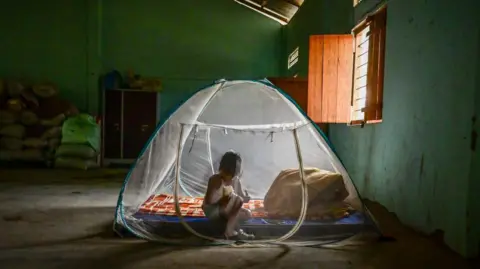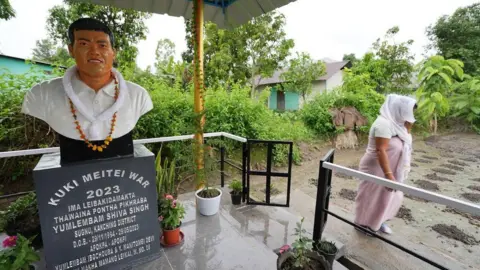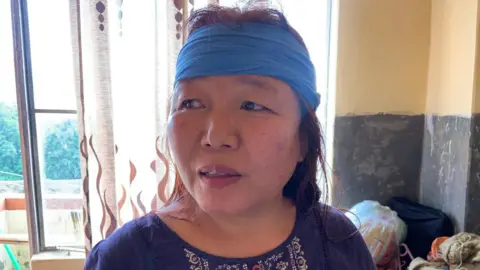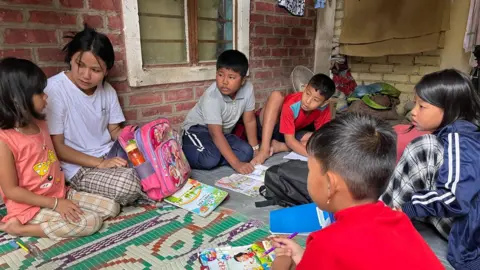
 Getty Images
Getty ImagesIt’s been more than a year since a deadly ethnic conflict devastated homes and claimed more than 220 lives in India’s northeastern state of Manipur. But its more than three million residents still await peace.
Clashes erupted in May last year between the majority Meitei and the indigenous Kuki minority, sparked by protests by the Kuki against the Meitei’s demands for official tribal status, which would have made them eligible for affirmative action and other benefits.
The violence has displaced tens of thousands of people, with some 59,000 still living in government relief camps. It has divided neighborhoods and torn ties between communities.
Today, Manipur is divided into two camps, with the Meiteis inhabiting the Imphal Valley and the Kukis living in the surrounding hilly areas. Borders and buffer zones guarded by security forces separate the two regions. Many locals have voluntarily taken up arms, some stolen from the armed forces, some manufactured in the country, to protect their villages from intruders.
Federal and state officials have attempted to end the conflict by holding peace talks between communities, but locals say it hasn’t been enough: a recent peace deal was signed in one district collapsed within a day. Mistrust between the two groups persists and incidents of violence, including killings of security personnelare reported regularly.
“The situation in Manipur is still tense and full of mistrust because people need to be confident that they can move forward, and to move forward, there has to be some resolution of the past. There hasn’t been one,” says Sanjoy Hazarika, a commentator and author specializing in India’s northeastern states.
Both communities accuse each other of fomenting violence.
The state government and the Meitei community have often blamed the conflict on illegal immigration, particularly from neighboring Myanmar. The Kuki community, which shares ethnic ties with the Chin in Myanmar, say this narrative has been used to target them within their own state.
“The state needs a full-scale intervention: militarily to stop the violence and psychologically to start negotiations. The establishment of trust [between Kukis and Meiteis] is crucial. Trust cannot be built in a day,” says Shreema Ningombam, a political analyst in Imphal, the state capital.

 Anshuul Verma
Anshuul VermaAt the village of Sugnu, about 60 km (37 miles) from Imphal, the gap is stark.
Both Meiteis and Kukis once lived here, but the latter fled to the surrounding hills after the conflict began, leaving behind burned and looted homes.
Despite security measures, locals fear reprisal attacks by “outsiders”. Meitei women’s groups, known as Meira Paibis, guard village entry points.
Yumlembam Manitombi, one of the guards, said he lost his 29-year-old son in the violence last year. He was the eldest of his three children and the sole breadwinner.
They installed a bust of him in the courtyard of their house. An engraving under the bust indicates the reason for his death: Kuki Meitei War 2023.
“I want peace. Ending this war is my only wish and I am not looking for anything else,” says Mrs. Manitombi.
United in sadness
In Churachandpur, the epicenter of the Kuki-dominated conflict, similar security measures exist. The entrance to the town features a “Wall of Remembrance” commemorating the Kukis who died in the conflict.
Boinu Haokip and his family fled from Sugnu to Churachandpur last year to escape violence and now survive on odd jobs.
Ms Haokip, who is pursuing a degree in ethnic violence in Manipur, says her future looks bleak.
“I have to study and take care of my family. Our society has been in poverty for generations. We had started to get out of it, but this violence has set us back at least a decade,” she says.
Questions about the future haunt others, too, as schools become makeshift camps. People have lost businesses, land, and jobs, and have exhausted their savings.
The conflict has also forced some to flee to camps in the neighboring state of Mizoram. With shortages of food, water and medicine, people are relying on casual jobs to survive.
Nengnei Chong, 52, fled with her two children and is living in a relief camp outside Mizoram’s capital, Aizawl. But she says she regrets her decision to leave.
“It would have been better if we had died at home too,” he says.
Mizoram MP TBC Lalvenchhunga says the state government has limited resources.
“The government is in financial trouble. If the federal government listen to our repeated requests [for more funds]we can help refugees better,” he says.

 Dilip Kumar Sharma
Dilip Kumar SharmaPolitical Accusation Game
Locals accuse the federal and Manipur governments, led by the Bharatiya Janata Party, of not doing enough to quell the violence.
Kuki groups have accused state authorities of ignoring the Meiteis’ violence for political gain, which the government denies. Opposition parties say the federal government has let the conflict rage for too long. The Congress party has repeatedly criticized Prime Minister Narendra Modi for not visiting Manipur.
“Our government is making serious efforts to restore normalcy in Manipur. Schools, colleges and offices in most places have reopened and are functioning. The hope of peace is visible,” Mr Modi said in Parliament recently.
But experts say mistrust between the two communities has only increased and the divide has deepened, with the Kukis adamantly demanding a “separate administration”, something the Meiteis vehemently oppose.

 Mayuresh Konnur
Mayuresh Konnur“Peacebuilding is a very painful and slow process. It is easier to give in to violence than to build peace. If the center [federal government] “If we can bring both sides to the negotiating table, it will be a step in the right direction,” says Mr. Hazarika.
But he warns that it won’t be a quick process.
“Healing takes time and patience before you can really move forward.”
With contributions from Dilip Kumar Sharma in Mizoram





